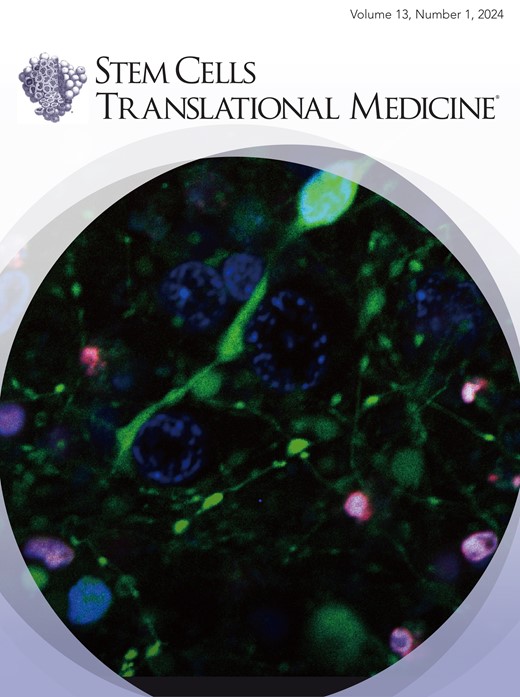揭示凋亡:其对自体和异体胼胝体模拟的免疫反应和异位骨重塑的影响。
IF 4.9
2区 医学
Q1 CELL & TISSUE ENGINEERING
引用次数: 0
摘要
软骨内骨再生是再生医学中一种前景广阔的方法。胼胝体模拟物(CMs)经工程改造,植入后可重塑为骨组织。其长期目标是为患者提供一种可持续的现成治疗方案。引入去腐化技术是为了便于储存,而使用异体(供体)细胞将进一步推动现成方法的发展。然而,用于骨再生的异体骨髓造血干细胞存在潜在的抗原性问题。在此,我们探讨了在活力或失活状态下植入合成或异体 CM 时,失活对抗原性和骨诱导性骨形成的影响。为此,我们使用异体免疫功能健全的异位大鼠模型植入了软骨分化的大鼠间充质基质细胞。活力充沛的同种异体间充质干细胞显示出最高的骨形成,而活力充沛的异种间充质干细胞显示出最低的骨形成,而两种凋亡的间充质干细胞显示出相当的中间骨形成水平。在骨形成之前,7 天和 14 天抗酒石酸磷酸酶染色水平与最终骨形成水平成正比。在骨形成前后的任何时间点,均未观察到局部先天性免疫反应的差异。相比之下,异体骨髓造血干细胞会引起轻微的适应性免疫反应,但仍能在免疫功能正常的环境中形成骨,尽管与自体活体相比形成骨的速度有所降低。总之,在植入自体 CM 时,去活性会延迟骨形成,而在异体 CM 中,去活性则会加速骨形成,这凸显了这种方法在实现现成治疗方面的潜力。本文章由计算机程序翻译,如有差异,请以英文原文为准。
Unraveling devitalization: its impact on immune response and ectopic bone remodeling from autologous and allogeneic callus mimics.
Endochondral bone regeneration is a promising approach in regenerative medicine. Callus mimics (CMs) are engineered and remodeled into bone tissue upon implantation. The long-term objective is to fabricate a sustainable off-the-shelf treatment option for patients. Devitalization was introduced to facilitate storage and using allogeneic (donor) cells would further propel the off-the-shelf approach. However, allogeneic CMs for bone regeneration pose a potential antigenicity concern. Here, we explored the impact of devitalization on antigenicity and osteoinductive bone formation when implanting syngeneic or allogeneic CM in a vital or devitalized state. For this, we implanted chondrogenically differentiated rat-derived mesenchymal stromal cells using an allogeneic immunocompetent ectopic rat model. Vital syngeneic CMs demonstrated the highest bone formation, and vital allogeneic CMs showed the lowest bone formation, while both devitalized CMs showed comparable intermediate levels of bone formation. Preceding bone formation, the level of tartrate-resistant acid phosphatase staining at 7 and 14 days was proportional to the level of eventual bone formation. No differences were observed for local innate immune responses at any time point before or after bone formation. In contrast, allogeneic CMs elicit a mild adaptive immune response, which still permits bone formation in an immunocompetent environment, albeit at a reduced rate compared to the autologous living counterpart. Overall, devitalization delays bone formation when autologous CMs are implanted, whereas it accelerates bone formation in allogeneic CMs, highlighting the potential of this approach for achieving off-the-shelf treatment.
求助全文
通过发布文献求助,成功后即可免费获取论文全文。
去求助
来源期刊

Stem Cells Translational Medicine
CELL & TISSUE ENGINEERING-
CiteScore
12.90
自引率
3.30%
发文量
140
审稿时长
6-12 weeks
期刊介绍:
STEM CELLS Translational Medicine is a monthly, peer-reviewed, largely online, open access journal.
STEM CELLS Translational Medicine works to advance the utilization of cells for clinical therapy. By bridging stem cell molecular and biological research and helping speed translations of emerging lab discoveries into clinical trials, STEM CELLS Translational Medicine will help move applications of these critical investigations closer to accepted best patient practices and ultimately improve outcomes.
The journal encourages original research articles and concise reviews describing laboratory investigations of stem cells, including their characterization and manipulation, and the translation of their clinical aspects of from the bench to patient care. STEM CELLS Translational Medicine covers all aspects of translational cell studies, including bench research, first-in-human case studies, and relevant clinical trials.
 求助内容:
求助内容: 应助结果提醒方式:
应助结果提醒方式:


